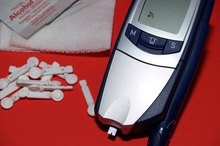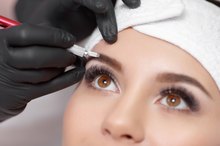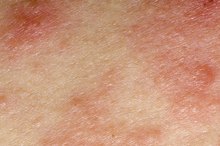What does fact checked mean?
At Healthfully, we strive to deliver objective content that is accurate and up-to-date. Our team periodically reviews articles in order to ensure content quality. The sources cited below consist of evidence from peer-reviewed journals, prominent medical organizations, academic associations, and government data.
- Mayo Clinic: Causes of Dark Circles Under Eyes
- Mayo Clinic: Definition of Atopic Dermatitis
- Mayo Clinic: Symptoms of Atopic Dermatitis
- Mayo Clinic: Nasal Congestion Definition
- Medline Plus: Cushing’s Disease
The information contained on this site is for informational purposes only, and should not be used as a substitute for the advice of a professional health care provider. Please check with the appropriate physician regarding health questions and concerns. Although we strive to deliver accurate and up-to-date information, no guarantee to that effect is made.
Pathologic Dark Circles Around the Eyes
Pathologic dark circles around your eyes dark circles around your eyes may be a symptom caused by a disease or by conditions that are symptoms of a disease 1. Diseases that lead to dark circles may affect your hormone levels, body fluids and tissues throughout your body. The Mayo Clinic recommends working with your doctor or healthcare professional to get an accurate diagnosis.
If you are experiencing serious medical symptoms, seek emergency treatment immediately.
Atopic Dermatitis
The Mayo Clinic indicates that pathologic dark circles around your eyes may occur with atopic dermatitis 123. Atopic dermatitis is a chronic or long-term skin disease that is also known as eczema. Your skin may itch or become inflamed and you may experience asthma attacks or hay fever if you have eczema. You may develop eczema as an adult or early in life as an infant and it can affect any area, including the area around your eyes. Eczema may cause itchy red or brown patches on the skin around your eyes, including your eyelids.
- The Mayo Clinic indicates that pathologic dark circles around your eyes may occur with atopic dermatitis 1.
- You may develop eczema as an adult or early in life as an infant and it can affect any area, including the area around your eyes.
Pathological Nasal Congestion
Diseases With Symptoms Similar to Diabetes
Learn More
You may develop dark circles around your eyes with illnesses that cause nasal congestion. The common cold, influenza, sinusitis and rhinitis all may cause nasal congestion. Nasal congestion that occurs with these and other diseases may contribute to dark circles around your eyes, because it dilates and darkens the veins that drain fluid from your eyes to your nose.
- You may develop dark circles around your eyes with illnesses that cause nasal congestion.
- Nasal congestion that occurs with these and other diseases may contribute to dark circles around your eyes, because it dilates and darkens the veins that drain fluid from your eyes to your nose.
Thinning Skin
Diseases that cause your skin to thin may lead to dark circles around your eyes. For example, Cushing’s disease occurs when your body is exposed to too much adrenocorticotropic hormone 5. Excessive amounts of this hormone subsequently expose your body to more of the stress hormone cortisol. According Medline Plus, skin changes like thinning and easily bruised skin are common with Cushing’s disease 5.
Collagen Vascular Diseases
Causes of a Skin Rash on Hands and Feet
Learn More
You may get dark circles around your eyes due to diseases that can cause collagen loss in your skin and other body tissues. For example, dermamytositis is a collagen vascular disease that causes swelling and rashes on your skin. According to Medline Plus, the cause of dermamytositis is unknown but may result from immune system problems or a viral infection in your muscles. Symptoms of collagen vascular diseases like dermamytositis include purple or violet-colored eyelids.
- You may get dark circles around your eyes due to diseases that can cause collagen loss in your skin and other body tissues.
- For example, dermamytositis is a collagen vascular disease that causes swelling and rashes on your skin.
Hypothyroidism
Hypothyroidism is a thyroid hormone deficiency disease. Hypothyroidism may occur at any age and is common in older adults. According to the Merck Manuals of Medical Information online database, obtaining a diagnosis for hypothyroidism may be easier for younger adults, because it may be more subtle or atypical in older adults. You may develop dark circles around your eyes, because hypothyroidism can cause an infiltration of complex sugar molecules in your face, which leads to swelling and discoloration in your face and around your eyes 1.
- Hypothyroidism is a thyroid hormone deficiency disease.
- According to the Merck Manuals of Medical Information online database, obtaining a diagnosis for hypothyroidism may be easier for younger adults, because it may be more subtle or atypical in older adults.
Related Articles
References
- Mayo Clinic: Causes of Dark Circles Under Eyes
- Mayo Clinic: Definition of Atopic Dermatitis
- Mayo Clinic: Symptoms of Atopic Dermatitis
- Mayo Clinic: Nasal Congestion Definition
- Medline Plus: Cushing’s Disease
- Sarkar R, Ranjan R, Garg S, Garg VK, Sonthalia S, Bansal S. Periorbital hyperpigmentation: A comprehensive review. J Clin Aesthet Dermatol. 2016;9(1):49–55.
- Vrcek I, Ozgur O, Nakra T. Infraorbital dark circles: A review of the pathogenesis, evaluation and treatment. J Cutan Aesthet Surg. 2016;9(2):65–72. doi:10.4103/0974-2077.184046
- American College of Allergy, Asthma, and Immunology. What are allergic shiners?
- Mukherjee, Pulok & Nema, Neelesh & Maity, Niladri & Sarkar, Birendra. (2012). Phytochemical and therapeutic potential of cucumber. Fitoterapia. 84. 10.1016/j.fitote.2012.10.003
- Marini A, Grether-beck S, Jaenicke T, et al. Pycnogenol® effects on skin elasticity and hydration coincide with increased gene expressions of collagen type I and hyaluronic acid synthase in women. Skin Pharmacol Physiol. 2012;25(2):86-92. doi:10.1159/000335261
- Ahmadraji, Fatemeh & Shatalebi, Mohammad. (2015). Evaluation of the clinical efficacy and safety of an eye counter pad containing caffeine and vitamin K in emulsified Emu oil base. Advanced biomedical research. 4. doi: 10.10.4103/2277-9175.148292.
Resources
Writer Bio
Miguel Cavazos is a photographer and fitness trainer in Los Angeles who began writing in 2006. He has contributed health, fitness and nutrition articles to various online publications, previously editing stand-up comedy and writing script coverage as a celebrity assistant. Cavazos holds a Bachelor of Arts in philosophy and political science from Texas Christian University.









